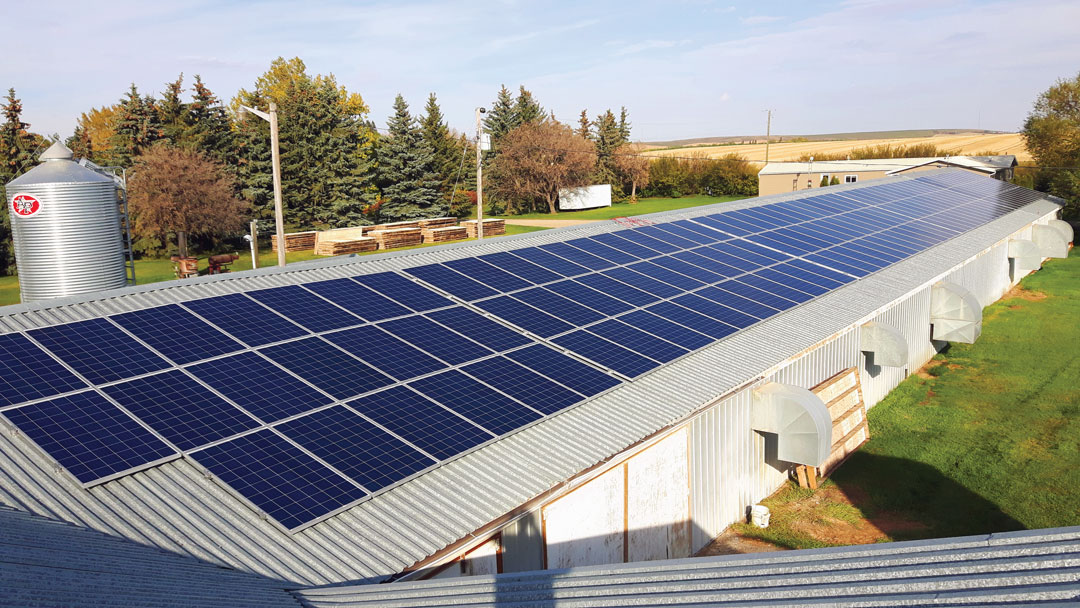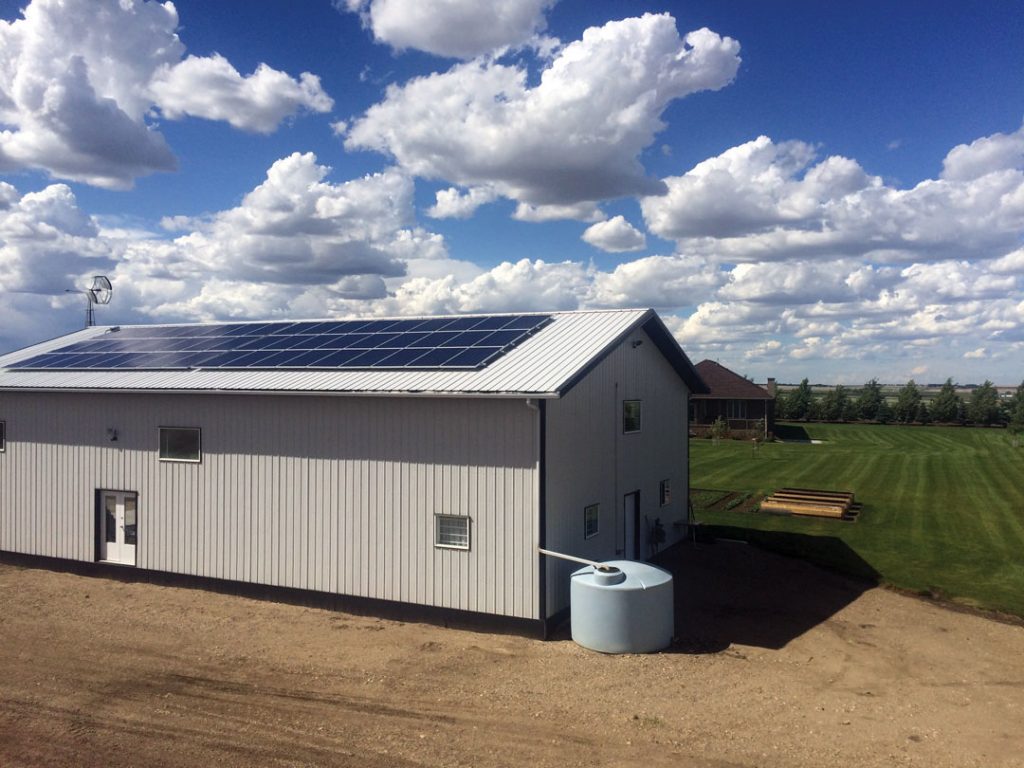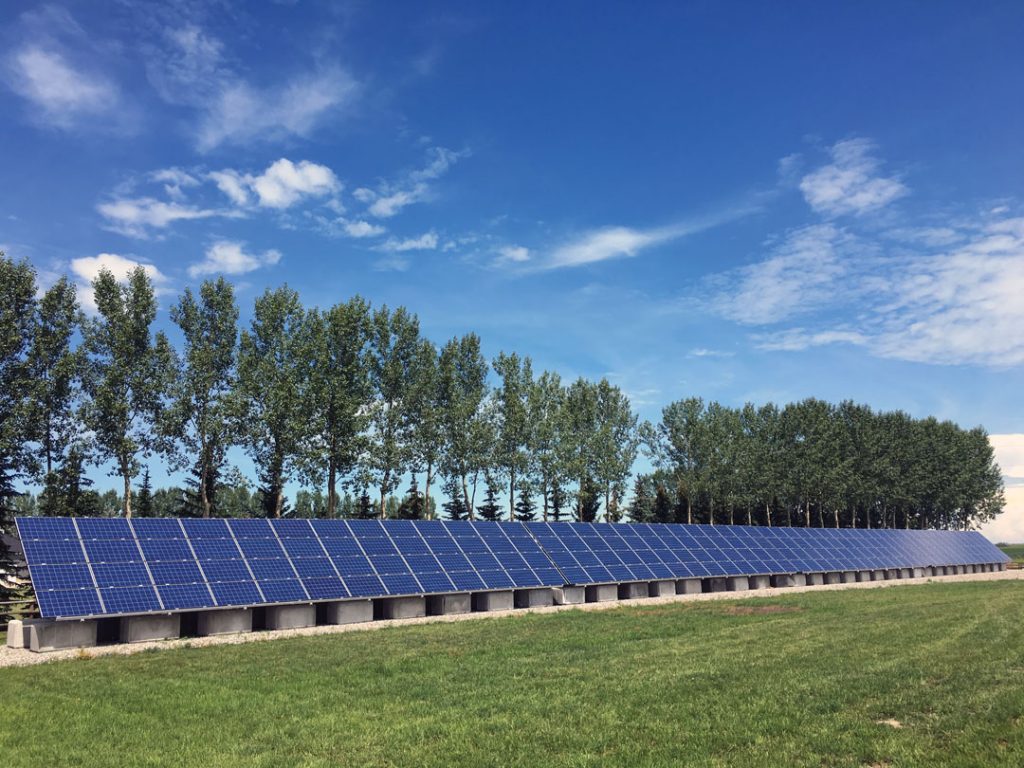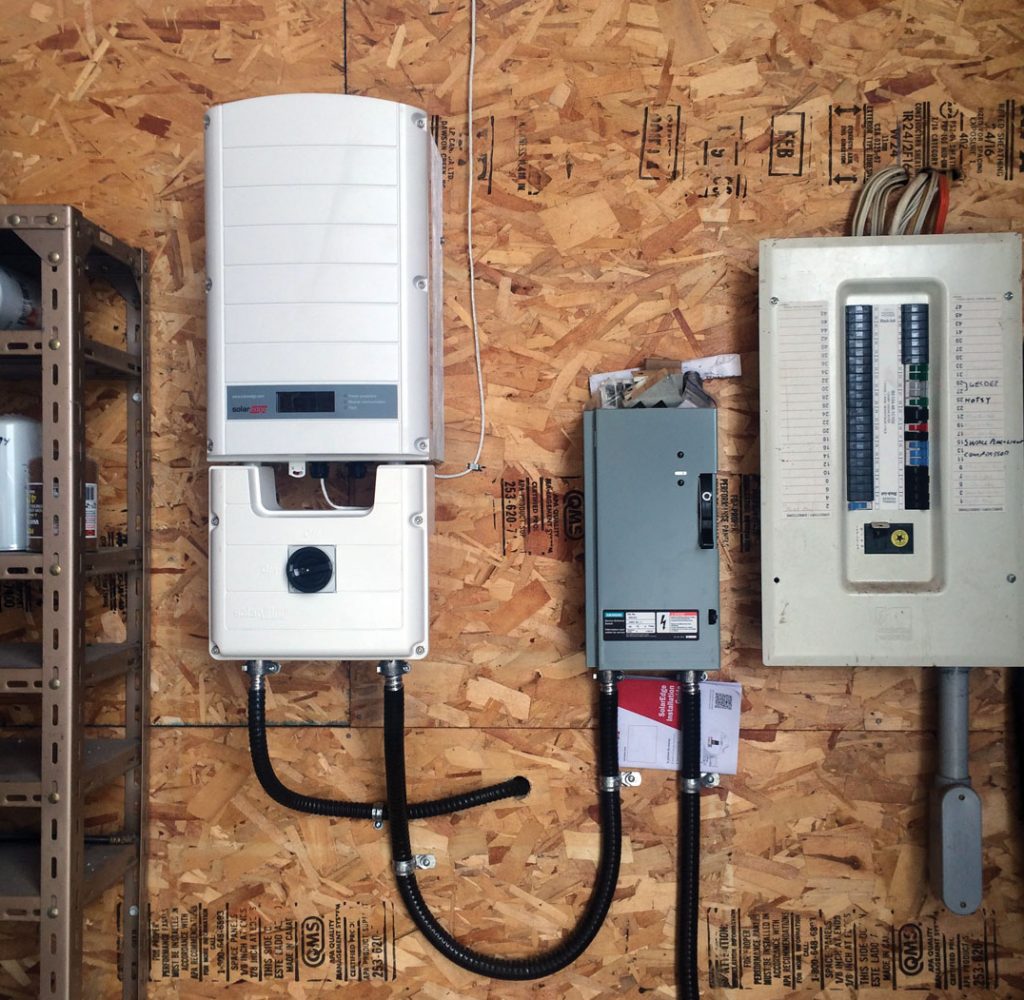HERE COMES THE SUN
ALBERTA FARMERS ARE HARVESTING MORE THAN JUST CROPS
BY TYLER DIFLEY
As the world has started to grapple with the short- and long-term consequences of burning fossil fuels, renewable energy sources have become all the rage. This has spurred researchers all around the world to try to find the next big energy breakthrough that will power human civilization for generations to come.
Among these renewables, one in particular has hogged the spotlight in recent months: solar. As Tesla Motors CEO Elon Musk is revealing his company’s innovative solar roof tiles and the world’s first solar road is opening in France, the humble solar panel is also slowly catching on with farmers right here in Alberta. Crops like wheat, barley, canola and peas harness the energy of the sun to fuel their growth, and farmers can now do the same— with a little help from some high-tech equipment.
Surprisingly, when you combine this cutting-edge technology with one of the oldest professions on the planet, you get a perfect match. Farmers have long been early adopters of new technology, always looking for the latest innovation that can give their operation an edge. Solar power generation has been no exception, especially in an environment where farmers are constantly looking for ways to save money while also becoming more sustainable long term.
According to David Vonesch, COO and partner with Alberta solar provider SkyFire Energy, 40 to 50 per cent of his company’s customers in the past year have been farmers. One of those customers was Alberta Barley delegate and Beiseker-area farmer Kenton Ziegler.
“It was something I’ve always been interested in,” Ziegler said. “Seven years ago, when we built our farm, I oriented my buildings in anticipation of putting solar panels on them. “It’s not something where I just said, ‘let’s do this.’ It’s about trying to be more sustainable on our farming operation.”
SkyFire Energy installed Ziegler’s 13.26kW solar photovoltaic (PV) system, which is made up of 51 roof-mounted panels, and it became operational on July 1, 2016.
“One of the highlights of my summer was watching that power meter run backward for the first time,” Ziegler said. “That was really cool.”
SUNNY WAYS
There are many reasons why solar technology has been a great fit for many Alberta farmers. First of all, thinking long term is never a problem in agriculture—it comes with the territory. As a result, farmers who invest in solar are rarely worried about waiting several years down the road before their sunk costs start paying dividends.
“Generally, agricultural customers are used to longer-term investments, having made them in land or machinery quite commonly,” Vonesch said. “Also, they’re typically not going anywhere. They plan to be on their land for a long period of time and often over multiple generations.”
Solar is uniquely well suited to Alberta agriculture for another reason, one that calls to mind the mantra of real estate agents everywhere: location, location, location. Just as location is one of the most important factors in determining the value of a house, location also dictates the power-generating capabilities of any given solar PV system. And it just so happens that Alberta is a prime location for catching some rays.
“The southeast corner of Alberta has the best solar resource in Canada,” Vonesch said. “To put it in perspective, on an annual basis, systems here in Alberta perform 50 to 60 per cent better than those same systems installed in Germany, which has more solar than anyone in the world.
“We get a lot of sun year round, and on an annual basis we get really good production out of these systems.”
The obvious benefit of installing an on-farm solar PV system from a business perspective is to save money on energy costs down the road, and many farmers elect to have a system installed in an effort to hedge against any future increases in the cost of electricity. Some look forward to reaping the cost benefits of “free” energy, once their total energy savings equal the cost of their system. However, others like Ziegler look beyond the dollar figures, to benefits that are a bit harder to quantify with ones and zeros.
As concerns about the environment, greenhouse gas emissions and climate change have intensified, agriculture has been put under the microscope. As a result, a number of efforts have been launched to cultivate social licence and show consumers that Canadian agriculture is sustainable and should be viewed primarily as part of the climate change solution, rather than the problem.
From this perspective, Ziegler found that installing a solar PV system on his farm went a long way to show urban Albertans that farmers are committed to sustainability and environmental stewardship. In theory, his system should produce as much electricity as his farm consumes, making his operation “net zero” when it comes to energy use.
“When I tell my city friends that I’ve put solar panels on, they think it’s really cool,” he said. “Right away, there was a little more credibility.”
Despite the advantages that solar has to offer from a financial and environmental perspective, the technology does come with a couple important caveats. Chief among these is the long period of time required for most solar PV systems to pay for themselves.
“Even as the price of solar PV equipment has dropped over the last two to five years, the price of electricity in Alberta has also dropped significantly,” said Kelly Lund, research engineer for on-farm energy systems at Alberta Agriculture and Forestry. “So the payback hasn’t changed all that much.
“We’re just saying, as a rough guide, it’s probably still an 18- to 20-year payback, depending on how big of a system size it is. Some may be able to do a bit better.”
Based on the long payback period for most solar PV systems, Ziegler emphasized the importance of approaching the process with the right long-term mindset. “It’s not a moneymaker,” he said. “Don’t ever think of this as a revenue stream. Think of it as offsetting your current consumption.”
SOLAR INCENTIVES
One factor that has helped convince some on-the-fence farmers to invest in solar technology is the availability of grant funding from the Government of Alberta through Growing Forward 2. Applications are fielded and grants are distributed through the On-Farm Solar Photovoltaics program.
“The Growing Forward 2 assistance for them has piqued a lot of interest and helped to improve the economics,” Vonesch said.
For Ziegler, who had longstanding plans to experiment with solar on his farm, the availability of grant funding was a nice bonus that allowed him to start the process ahead of schedule. “It wasn’t the driver for the decision, but the funding allowed me to do this three years earlier than I thought I could,” Ziegler said.
The On-Farm Solar Photovoltaics program has now been running for the better part of a year, and Lund said applications for funding have continued to trickle in at a reliable rate as farmer interest in solar slowly spreads across the province. “It’s kind of a slow and steady interest,” she said. “Certainly, every month we’re getting new applications. The interest is still out there.”
For qualifying farmers, the program funds solar PV systems at a rate of $0.45/watt for third-party contractor-installed systems, to a maximum of 20 per cent of the project costs. The program is “fairly modest by design,” according to Lund. But when systems roughly the same size as Ziegler’s can cost $30,000 to $40,000, saving 20 per cent can be significant. Self-installed systems are funded at a much lower rate, and both self- and contractor-installed systems qualify for funding at a higher rate if an energy assessment has been conducted.
To be eligible for the program, a farmer’s solar plans must meet several criteria. Important among these are requirements that solar PV systems must be connected to the grid and comply with Alberta’s micro-generation legislation.
“Any project that is submitted for approval has to qualify as a micro-generator. So they can only produce as much electricity on an annual basis as they would use, more or less,” Lund said. “It’s not an avenue for commercial generation.”
Currently, the program can fund up to a maximum of $50,000 or 100kW of solar generation capacity for each applicant. According to Vonesch, this has led the owners of many large-scale farming operations, which include a number of Hutterite colonies in the province, to wait for a better deal that could emerge down the road.
“They see this grant as maybe not enough for them to make a big leap into solar because they want to do a much larger system that has a more meaningful effect on their total energy use,” he said.
However, according to Lund, “if people can qualify for systems that are larger than that where we would max out, we’ll still fund to the limit. If they wanted to do a 250kW system, and that system still qualified as a micro-generator, we’d still fund to the limit of our program. It’s not that they would have to size it smaller to qualify.”
TAKING THE PLUNGE
For farmers who are interested in purchasing a solar PV system for their operation, once they get in touch with one of the province’s solar providers the process is relatively straightforward, according to Vonesch.
“We usually start with some high-level, ballpark numbers and the economics based on their [energy] consumption or what their size will allow for a system,” he said. “If that has piqued their interest still, then we’ll come out for an assessment where we’ll look at the structure we’re mounting to—or if it’s a ground-mount, that site and the shading on site— and then the electrical integration, and work through all those details to be able to get back to them with a firm quote and proposal.”
Farmers can choose between having their new solar PV system mounted on the roof of an existing structure on their farm or on the ground. According to Vonesch, the right mounting location varies depending on the customer, but a roof-mounted system will be cheaper because you don’t need to build foundations like you would for a ground-mounted setup.
“Even if you might not be at the perfect angle on the roof—often you’re lower pitched than we do for a ground mount—those losses from being at a non-optimum angle are more than made up for by the much lower system cost,” he said. “So you end up with a lower cost per hour of kilowatt energy produced overall by using an existing structure.”
There are a number of solar providers available to farmers in Alberta, but the costs can vary quite dramatically from company to company.
“When I was getting quotes, it paid to shop around,” Ziegler said. “Things change pretty fast in that industry and pricing does change.”
Lund agreed, and said it’s especially important to get the best deal available when you’re paying for both the equipment and its installation. “Any time you’re hiring a contractor and entering into a purchase-and-install contract, we definitely recommend getting usually at least three prices [quoted],” she said.
Once you’ve shopped around for the right solar provider, hashed out the details of your solar PV system and had it installed, the hard part is over.
“It’s quite a reliable technology and it’s virtually maintenance-free,” Lund said. “Once it’s installed, it’s pretty much guaranteed to operate for the life of the system with very few problems.”
Solar panels become less efficient at generating power as they age, but, thankfully, the drop-off in performance is less dramatic than you might think.
“The modules themselves have 25-year power output warranties,” Vonesch said. “So they slowly degrade over time, but they’re guaranteed to produce 80 per cent of their rated output at year 25.
“The inverter, the only other major component in the system, typically has a 10- or 12-year product warranty. That’s the weakest component in the system.” He added that most customers should expect to spend some money on maintenance or replacement for their inverter—which converts the direct current produced by solar panels into alternating current for the grid—after 15 to 20 years, but that SkyFire Energy factors in this cost when assessing the overall economics of the system.
The panels themselves are extremely durable, and can even withstand the vicious hailstorms that have long caused serious headaches for farmers across the province.
“Typically, if somebody is installing a system, we’re mounting them south-facing or at least at an angle of some kind,” Vonesch said. “In that case, we’ve never had a panel break from hail in the 15 years we’ve existed in Alberta, and many of our systems have seen some pretty major storms.”
A BRIGHTER FUTURE
Lund expects funding levels for the On-Farm Solar Photovoltaics program to remain constant for the immediate future, so there will be plenty of opportunities for interested farmers to apply for grants going forward.
Meanwhile, Ziegler said he hopes that at some point down the road, Alberta’s micro-generation rules might change to allow him to expand his current system. “I definitely would love to expand it, but currently the micro-generation laws in Alberta don’t allow me to produce more than I consume,” he said. “At this point in time, there are a whole bunch of reasons why that can’t happen, but it may be an option in the future.”
His ultimate goal is to take his system off-grid, which would allow him to store electricity generated by his solar PV system in batteries. However, he said, “currently, that’s cost prohibitive.”
For now, as more and more farmers start to consider the benefits of investing in this renewable energy source to fuel their operations, it seems the future of on-farm solar in Alberta is bright.
“I’d say we’re now past the early-adopters stage in that market and getting more into the mainstream market, where the average farmer is looking at it more and more seriously,” Vonesch said. “The price of these systems is continuously dropping as well, which obviously helps too. I think that market will continue to grow.”










Comments